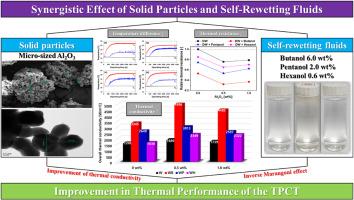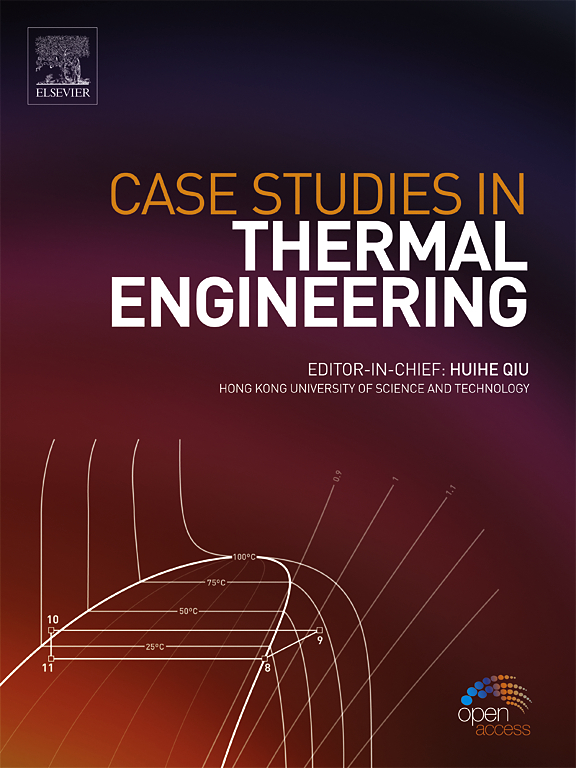Synergistic effect of Al2O3 particles and alcoholic fluids (butanol, pentanol, and hexanol) on thermal performance in a two-phase closed thermosyphon
IF 6.4
2区 工程技术
Q1 THERMODYNAMICS
引用次数: 0
Abstract
This study investigates the effects of adding micro-sized alumina particles and self-rewetting fluids (n-butanol at 6 wt%, n-pentanol at 2 wt%, and n-hexanol at 0.6 wt%) to distilled water (DW) on the thermal performance of a two-phase closed thermosyphon (TPCT). The thermal resistance of the TPCT was measured under various test conditions using DW and the three aforementioned self-rewetting fluids as working fluids. Additionally, the thermal performance of the TPCT was compared and analyzed in terms of the thermal resistance by incorporating alumina particles at concentrations of 0.5 % and 1 wt% into both DW and aqueous solutions. The results showed that butanol-, pentanol-, and hexanol-based self-rewetting fluids reduced the thermal resistance by 47 %, 25.7 %, and 15 %, respectively, compared to DW, which is attributable to the inverse Marangoni effect. The thermal resistance was further reduced by 24.3 % and 21.1 % when 0.5 wt% and 1 wt% alumina particles were added to DW, respectively. In particular, an additional reduction in the thermal resistance was achieved with working fluids of DW + self-rewetting fluids and alumina particles. The reductions were 67.9 %, 46.6 %, and 34.8 % for butanol-, pentanol-, and hexanol-based self-rewetting fluids, respectively, indicating a substantial enhancement in TPCT thermal performance.

Al2O3 粒子和酒精流体(丁醇、戊醇和己醇)对两相封闭热流器中热性能的协同效应
本研究探讨了在蒸馏水(DW)中添加微小尺寸的氧化铝颗粒和自润湿流体(6 wt%的正丁醇、2 wt%的正戊醇和 0.6 wt%的正己醇)对两相封闭式热吸附器(TPCT)热性能的影响。使用蒸馏水和上述三种自润湿流体作为工作流体,在各种测试条件下测量了 TPCT 的热阻。此外,通过在 DW 和水溶液中加入 0.5% 和 1 wt% 浓度的氧化铝颗粒,对 TPCT 的热阻性能进行了比较和分析。结果表明,与 DW 相比,丁醇基、戊醇基和己醇基自润湿流体的热阻分别降低了 47%、25.7% 和 15%,这归因于逆马兰戈尼效应。当在 DW 中添加 0.5 wt% 和 1 wt% 的氧化铝颗粒时,热阻分别进一步降低了 24.3 % 和 21.1 %。特别是在使用 DW + 自润湿液和氧化铝颗粒的工作液时,热阻进一步降低。丁醇基、戊醇基和己醇基自润湿流体的热阻分别降低了 67.9%、46.6% 和 34.8%,这表明 TPCT 的热性能得到了大幅提高。
本文章由计算机程序翻译,如有差异,请以英文原文为准。
求助全文
约1分钟内获得全文
求助全文
来源期刊

Case Studies in Thermal Engineering
Chemical Engineering-Fluid Flow and Transfer Processes
CiteScore
8.60
自引率
11.80%
发文量
812
审稿时长
76 days
期刊介绍:
Case Studies in Thermal Engineering provides a forum for the rapid publication of short, structured Case Studies in Thermal Engineering and related Short Communications. It provides an essential compendium of case studies for researchers and practitioners in the field of thermal engineering and others who are interested in aspects of thermal engineering cases that could affect other engineering processes. The journal not only publishes new and novel case studies, but also provides a forum for the publication of high quality descriptions of classic thermal engineering problems. The scope of the journal includes case studies of thermal engineering problems in components, devices and systems using existing experimental and numerical techniques in the areas of mechanical, aerospace, chemical, medical, thermal management for electronics, heat exchangers, regeneration, solar thermal energy, thermal storage, building energy conservation, and power generation. Case studies of thermal problems in other areas will also be considered.
 求助内容:
求助内容: 应助结果提醒方式:
应助结果提醒方式:


